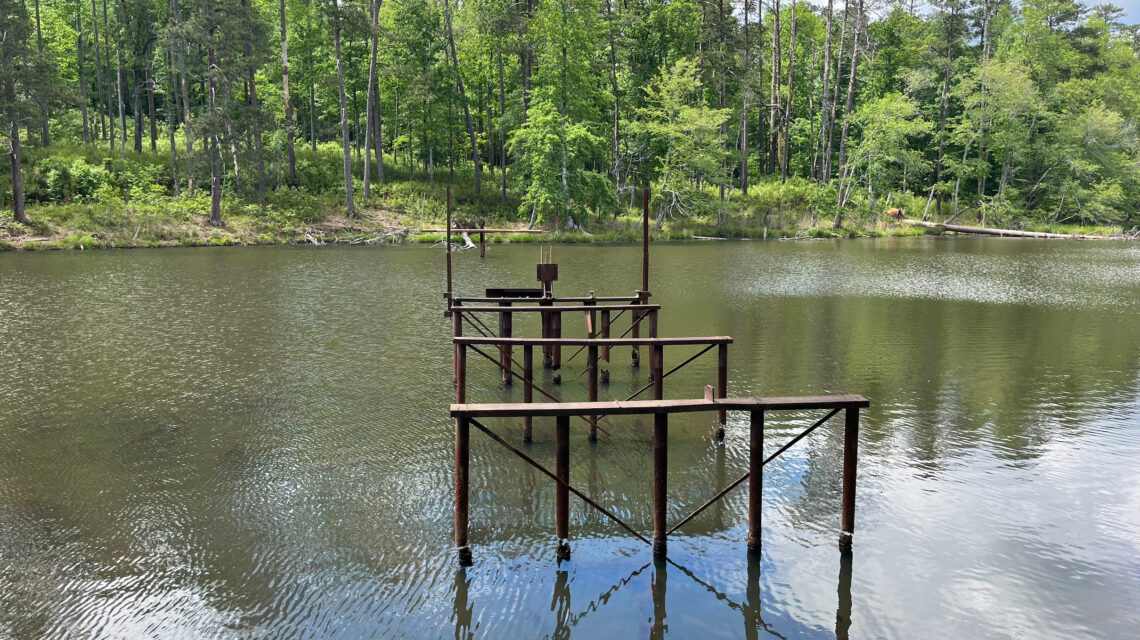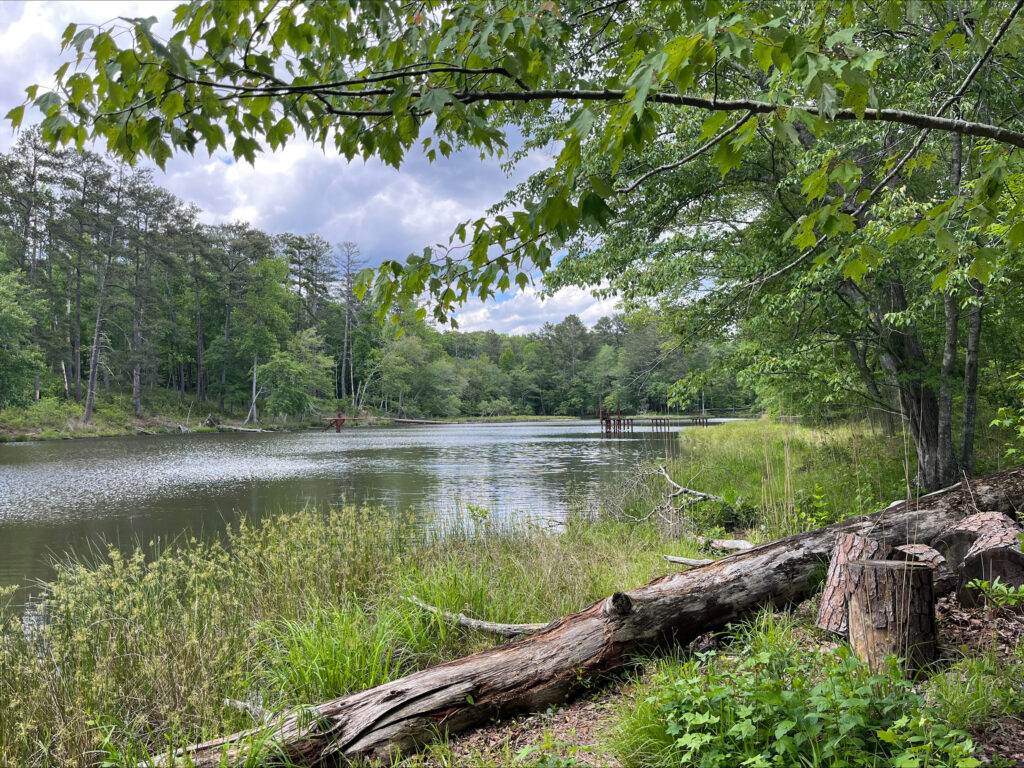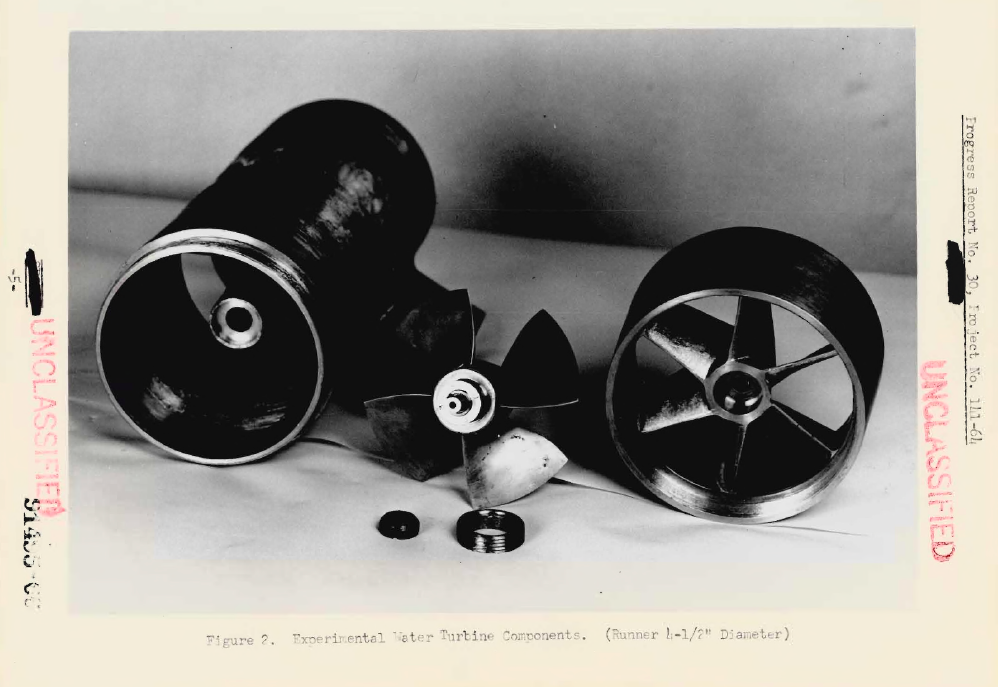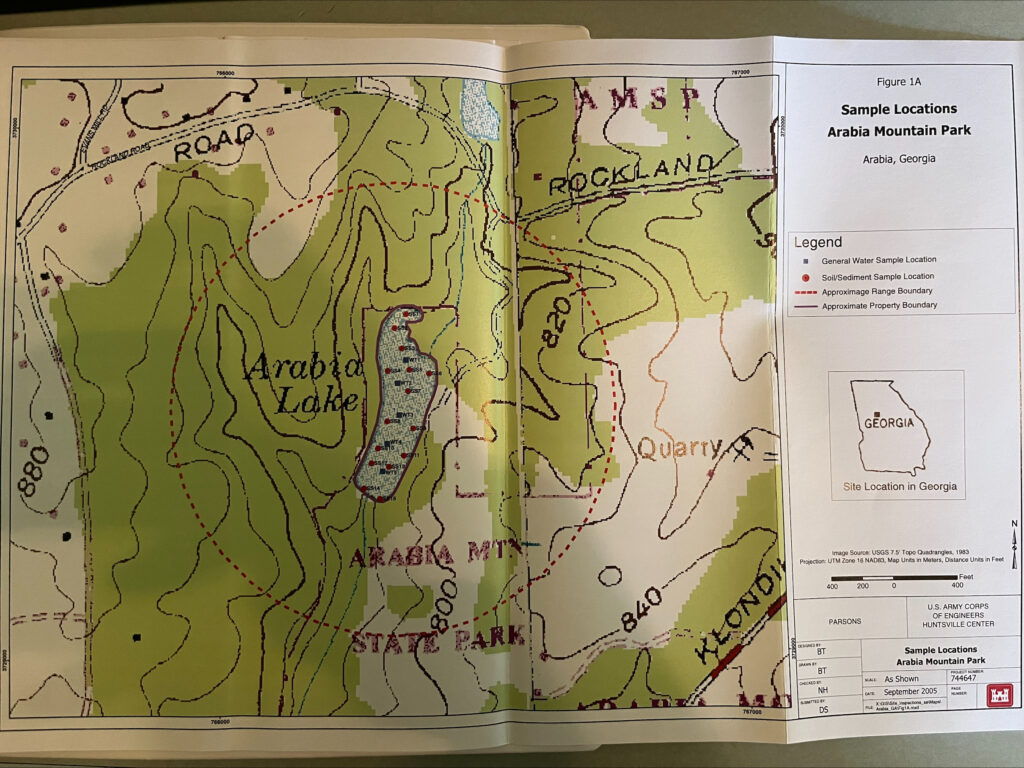That Time The Navy Tested Explosives At Arabia Lake

Rock quarrying seems to not have been the only source of explosions at Arabia Mountain…
Many sites around the Arabia Mountain National Heritage Area have been used for more than just recreation. Farming, quarrying, spiritual practice and even illegal moonshining have all been conducted within the boundaries of the NHA. But did you know that military explosive tests have been conducted at Arabia Lake? Thanks to documents from the Georgia Institute of Technology and the U.S. Army Corps of Engineers, we are able to get some insight into these obscure operations.
A Deeper Dive
Military testing having been conducted at Arabia Lake has been a recurring piece of information passed around by Arabia Mountain employees, mentioned on guided hikes passing the area, the mystique of which is amplified by unidentified metallic pillars emerging from the lake’s surface, extending from the docking area. Now we’re finally able learn about the tests and their purpose by dissecting documents produced by involved parties directly, and from a report documenting a project aimed to analyze the site in a broader operation to clean up potential leftover munitions at sites used for testing by the Department of Defense.

On the side of a rock outcrop behind the Davidson-Arabia Mountain Nature Preserve, Arabia Lake serves as a place to relax and enjoy some quiet.
Before there was a Davidson-Arabia Mountain Nature Preserve, the site of Arabia Lake was owned by Davidson Mineral Properties Inc., a quarrying company operating in the Stone Mountain and Lithonia area from 1930-1972 before it was donated to DeKalb County as a preserve (hence the “Davidson” in DAMNP). During this time, on October 9, 1951, the Navy detonated a range of explosives at Arabia Lake.
Documentation Uncovered
The Georgia Institute of Technology’s (GA Tech) Engineering Experiment Station had a hand in these tests, at one point even undertaking development of certain components (a “900 feet streamer”) under supervision of the Naval Ordnance Laboratory. A newspaper article dated 19 June, 1949 also stated that GA Tech leased the Arabia Lake area for Naval experimental work, although, no evidence of this lease has been found.
However, GA Tech’s Digital Repository does have previously classified progress reports on the experiments from the Department of the Navy, which conducted the tests in coordination with GA Tech’s Engineering Experiment Station. As it turns out, the testing wasn’t focused on studying the capabilities of the explosives themselves but on the strength of a rubber-coated aircraft cable produced by the B.F. Goodrich Company (now the Goodrich Corporation) and aluminum yoke attachments produced by the Aluminum Company of America when met with explosions. The Navy also used the site to test experimental water turbines as well as water resistant coatings by submerging materials for weeks in the lake and analyzing the effects.

A page from a formerly classified Navy document with a photo of one of the experimental water turbines tested at Arabia Lake in the early ’50s.
Environmental Impacts
A second document, created by the U.S. Army Corps of Engineers Southeast and Pacific IMA Region, was uncovered recently by Arabia Alliance staff from our stored files. Dated November 2005, this printed evaluation of Arabia Lake was part of the Formerly Used Defense Sites in the Military Munitions Response Program (FUDS MMRP) Site Inspection Project, which assessed the potential lasting environmental impacts of munitions testing by the Department of Defense.
The U.S. Army Corps of Engineers Southeast and Pacific IMA Region’s report gives us more of an outside look, yet still an interesting one. This document provides insight into the types of explosives tested at Arabia Lake. Reportedly the explosives tested comprised of Torpex, Composition C-4, black powder, Composition C-3, Cast HBX-1, HBX-2 and Primacord, ranging from 1 to 90lb bombs tested at underwater depths of up to 10ft.
The environmental report also provides details on the team’s visits to and analyses of Arabia Lake, which determined that the lake was free of munition and residuals. A map showing locations of water and soil sampling illustrates a portion of this process.

A map from the U.S. Army Corps of Engineers Southeast and Pacific IMA Region’s document depicts water and soil sampling at Arabia Lake as part of a project to detect munition residuals.
Remaining Mysteries
Based on an interview mentioned in the U.S. Army Corps of Engineers environmental report at Arabia, there is also evidence of previous testing or industry of some sort at the site. This indicates that the pillars in the middle of Arabia Lake and a “Quonset hut structure along the shore” (which is the corrugated metal to the right of the old dock before the granite outcropping) were present before the Navy tests. It’s not known if these structures were part of the Davidson quarry operation or if they predated it.
It’s also not known why the Navy would choose Arabia Lake. Perhaps because the location offered a more isolated environment, and the sound of explosives wouldn’t alarm locals as the Davidson Granite Co. regularly used dynamite in their operations. However, these are suppositions only. We may never be able to answer all these questions, but that’s part of what makes history so fun and fascinating—it’s an investigation of the past.